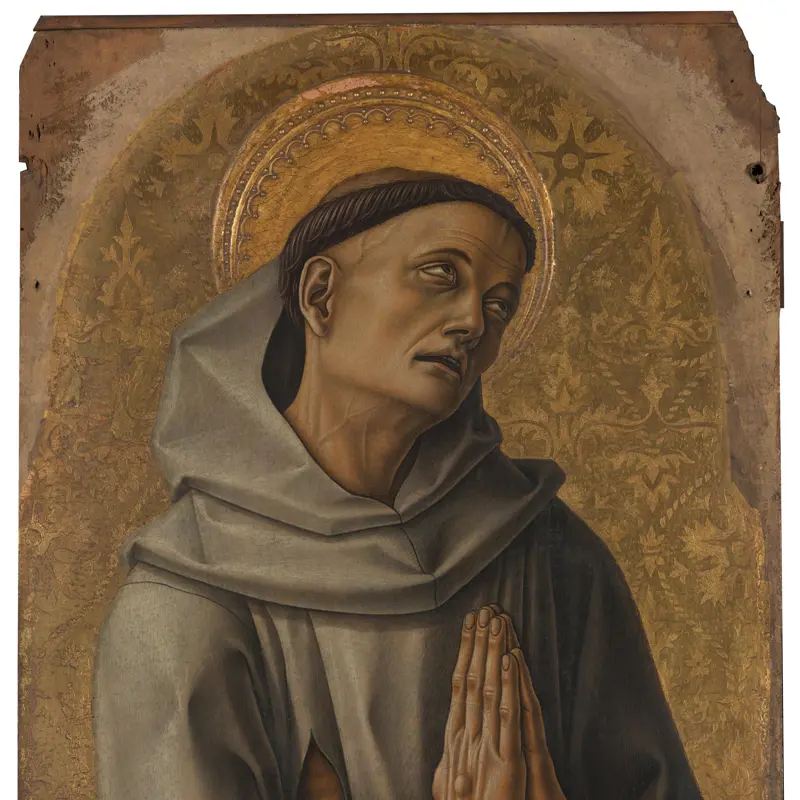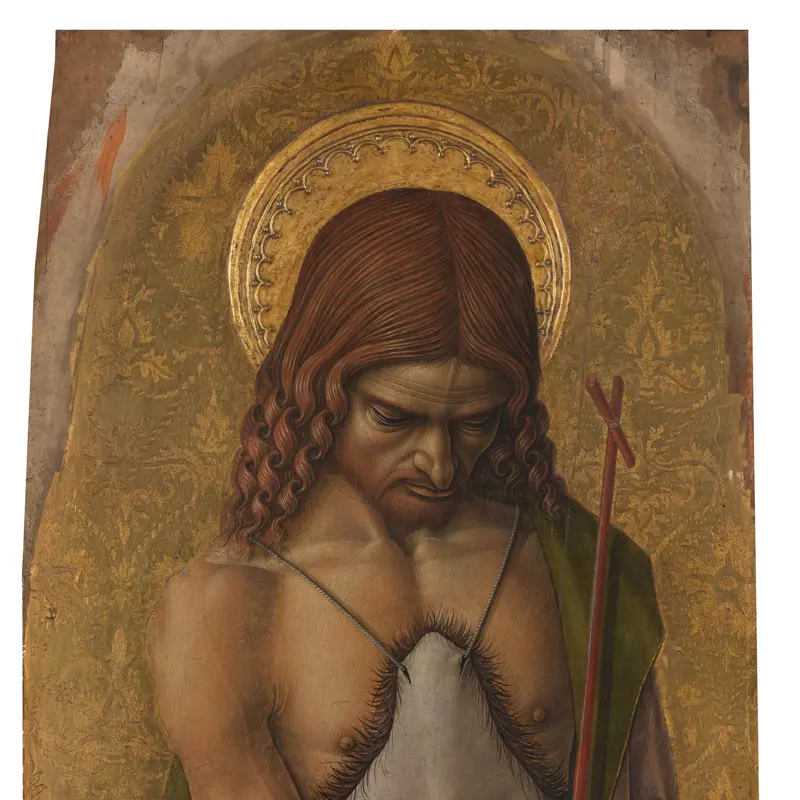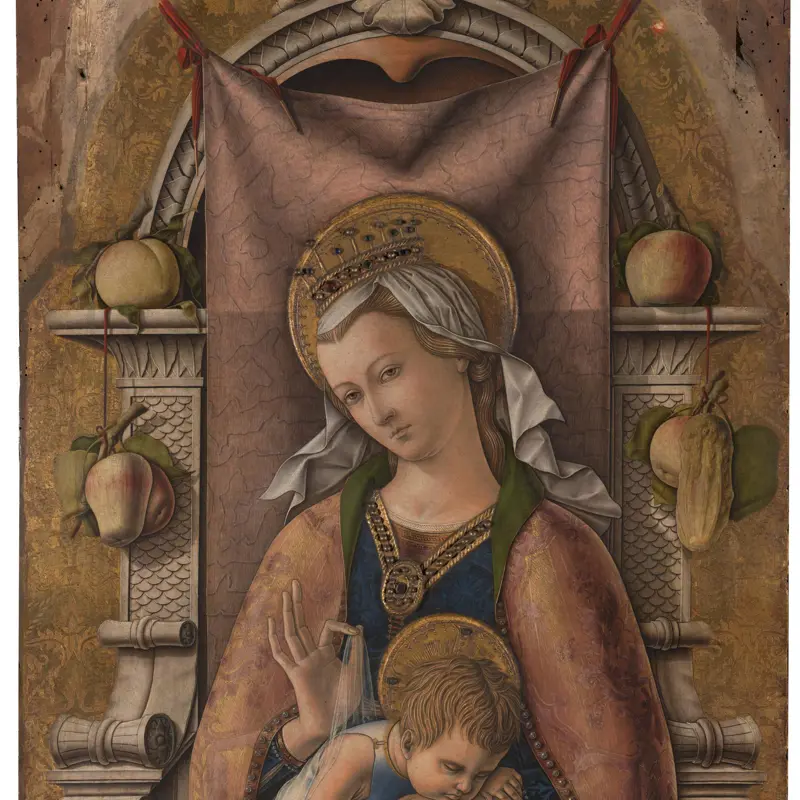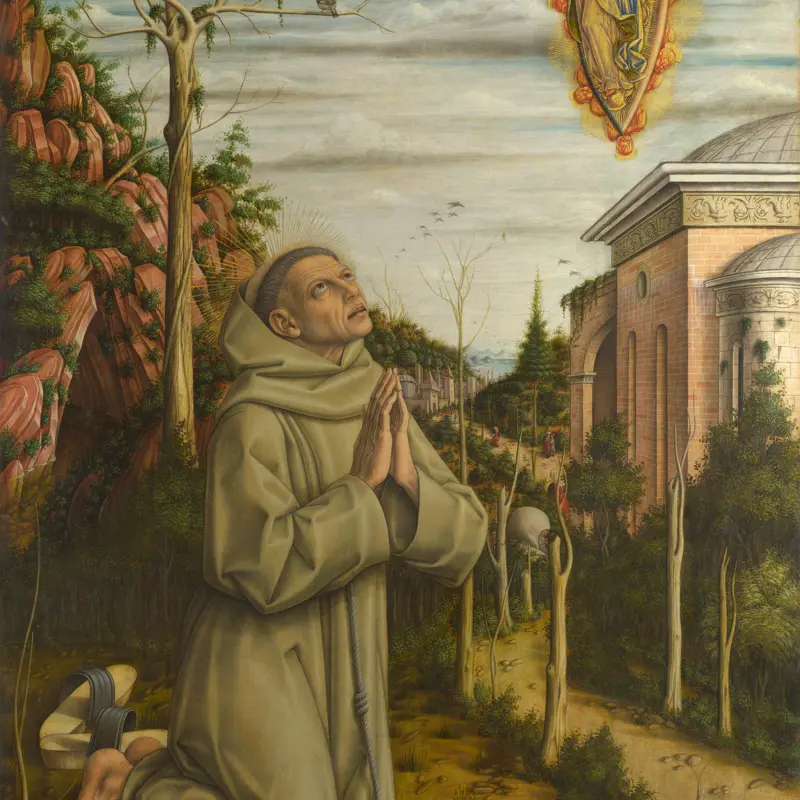Carlo Crivelli, 'The Annunciation, with Saint Emidius', 1486
About the work
Overview
The Archangel Gabriel descends from God to tell the Virgin that she is to bear a child – a moment known as the Annunciation – but has been distracted from his mission by a bishop saint, who has stopped him in the street of a Renaissance town. This is Saint Emidius, patron saint of the town of Ascoli Piceno in the Italian Marches. This painting is unique in showing a local saint effectively intervening in a biblical event.
Ascoli was ruled by the pope but was granted a degree of self-government in 1482. The news arrived on 25 March, the feast of the Annunciation. From this time onward this feast was celebrated with a great procession to the convent of the Observant Friars, for whom this altarpiece was made.
The coats of arms along the base are those of the pope, the town and its bishop, while the inscription, ‘LIBERTAS ECCLESIASTICA’, was the title of the papal bull granting Ascoli its rights.
Key facts
Details
- Full title
- The Annunciation, with Saint Emidius
- Artist
- Carlo Crivelli
- Artist dates
- about 1430/5 - about 1494
- Date made
- 1486
- Medium and support
- egg tempera with some oil on canvas
- Dimensions
- 207 × 146.7 cm
- Inscription summary
- Signed; Dated
- Acquisition credit
- Presented by Lord Taunton, 1864
- Inventory number
- NG739
- Location
- Room 59
- Collection
- Main Collection
- Frame
- 19th-century English Frame
Provenance
Additional information
Text extracted from the ‘Provenance’ section of the catalogue entry in Martin Davies, ‘National Gallery Catalogues: The Earlier Italian Schools’, London 1986; for further information, see the full catalogue entry.
Exhibition history
-
2009Carlo Crivelli a BreraPinacoteca di Brera26 November 2009 - 28 March 2010
-
2012Masterpieces from Museums of the World at the HermitageThe State Hermitage Museum14 February 2012 - 27 May 2012
-
2014Building the Picture: Architecture in Italian Renaissance PaintingThe National Gallery (London)30 April 2014 - 21 September 2014
-
2015Ornament and Illusion: Carlo Crivelli of VeniceIsabella Stewart Gardner Museum22 October 2015 - 25 January 2016
-
2020Masterpieces from the National Gallery, LondonThe National Museum of Western Art18 June 2020 - 18 October 2020The National Museum of Art3 November 2020 - 31 January 2021
-
2021Botticelli to Van Gogh: Masterpieces from the National Gallery, LondonNational Gallery of Australia5 March 2021 - 14 June 2021
-
2022Carlo Crivelli. Shadows on the SkyIkon Gallery23 February 2022 - 29 May 2022
Bibliography
-
1724D.T. Lazzari, Ascoli in prospettiva: Colle sue più singolari pitture, sculture e architetture, Ascoli 1724
-
1766F.A. Marcucci, Saggio delle cose ascolane e de'vescovi di Ascoli nel Piceno dalla fondazione della città sino… all'anno mille settecento sessanta sei, Teramo 1766
-
1790B. Orsini, Descrizione delle pitture, sculture, architetture ed altre cose rare della insigne città di Ascoli nella Marca, Perugia 1790
-
1830G. Cantalamessa-Carboni, Memorie intorno i letterati e gli artisti della città di Ascoli nel Piceno, Ascoli 1830
-
1834A. Ricci, Memorie storiche delle arti e degli artisti della Marca di Ancona, Macerata 1834
-
1892G. Frizzoni, La Galleria Morelli in Bergamo, Bergamo 1892
-
1900G.M. Rushforth, Carlo Crivelli, London 1900
-
1900C. Mariotti, 'Oggetti sacri d'argento esulati da Ascoli nel 1796', Rassegna bibliografica dell'arte italiana, III, 1900
-
1901G. Carotti, Catalogo della R. Pinacoteca di Brera, Milan 1901
-
1901A. Venturi, Storia dell'arte italiana, 11 vols, Milan 1901
-
1901G. Cantalamessa, 'Un dipinto di Carlo Crivelli nella Pinacoteca Vaticana', Rassegna d'arte, I, 1901, pp. 49-53
-
1907C. Ricci, La Pinacoteca di Brera, Bergamo 1907
-
1907L. Venturi, Le origini della pittura veneziana 1300-1500, Venice 1907
-
1909B. Berenson, The Venetian Painters of the Renaissance, 3rd edn, New York 1909
-
1916B. Berenson, Venetian Painting in America, New York 1916
-
1923R. van Marle, The Development of the Italian Schools of Painting, 19 vols, The Hague 1923
-
1927F. Drey, Carlo Crivelli und seine Schule, Munich 1927
-
1932B. Berenson, Italian Pictures of the Renaissance: A List of the Principal Artists and Their Works, with an Index of Places, Oxford 1932
-
1936B. Berenson, Pitture italiane del Rinascimento: Catalogo dei principali artisti e delle loro opere con un indice dei luoghi, Milan 1936
-
1937F.J. Mather, Venetian Painters, London 1937
-
1946R. Longhi, Viatico per cinque secoli di pittura veneziana, Florence 1946
-
1947M. Davies, Carlo Crivelli: The Annunciation, London 1947
-
1951Davies, Martin, National Gallery Catalogues: The Earlier Italian Schools, London 1951
-
1952P. Zampetti, Carlo Crivelli nelle Marche, Urbino 1952
-
1957R. Pallucchini, La pittura veneta del Quattrocento, parte II: La diffusione del Mantegnismo nel Veneto dal Crivelli a Giovanni Bellini, Padua 1957
-
1961A. Bovero, Tutta la pittura del Crivelli, Milan 1961
-
1961P. Zampetti, Crivelli e i Crivelleschi (exh. cat. Palazzo Ducale (Venice), 10 June -10 October 1961), Venice 1961
-
1975A. Bovero, L'opera completa del Crivelli, Milan 1975
-
1984T. Zanobini Leoni, 'Carlo Crivelli: L'annunciazione della National Gallery di Londra', Critica d'arte, XLIX/2, 1984, pp. 93-6
-
1986Davies, Martin, National Gallery Catalogues: The Earlier Italian Schools, revised edn, London 1986
-
1986P. Zampetti, Carlo Crivelli, Florence 1986
-
1990T. Lenain, 'Y-a-t-il une crise de la représentation dans la peinture classique?', Annales d'histoire de l'art et d'archéologie, XII, 1990, pp. 91-108
-
1991J. Dunkerton et al., Giotto to Dürer: Early Renaissance Painting in the National Gallery, New Haven 1991
-
1992K.H. Hofmann, Verkündigung mit St-Emidius von Carlo Crivelli: Eine geometrische Analyse, Darmstadt 1992
-
1993R. White and J. Pilc, 'Analyses of Paint Media', National Gallery Technical Bulletin, XIV, 1993, pp. 86-94
-
1995E.H. Gombrich, Shadows: The Depiction of Cast Shadows in Western Art (exh. cat. The National Gallery, 26 April - 18 June 1995), London 1995
-
1998F. Gennari Santori, 'They will form such an Ornament for our Gallery: La National Gallery e la pittura di Carlo Crivelli', in A.C. Tommasi (ed.), Giovanni Battista Cavalcaselle conoscitore e conservatore: Atti del convegno, Legnago, 28 novembre 1997-Verona, 29 novembre 1997, Venice 1998, pp. 291-312
-
1999M. Massa (ed.), Il patrimonio disperso: Il 'caso' esemplare di Carlo Crivelli: Atti delle giornate di studio, Montefiore dell'Aso, Camerino, Porto San Giorgio, 12 ottobre, 26 ottobre, 9 novembre 1996, Ripatransone 1999
-
2001
C. Baker and T. Henry, The National Gallery: Complete Illustrated Catalogue, London 2001
-
2001S. Weigel, 'Die Richtung des Bildes: Zum Links-Rechts von Bilderzahlungen und Bildbeschreibungen in kultur- und mediengeschichtlicher Perspektive', Zeitschrift für Kunstgeschichte, LXIV, 2001, pp. 449-74
-
2002T. Golsenne, 'L'annonciation de Carlo Crivelli et le probleme de l'ornement', Studiolo, 1, 2002, pp. 149-76
-
2004M. Feuillet, L'annonciation Sous Le Regard des Peintres, Marne 2004
-
2004R. Lightbown, Carlo Crivelli, New Haven 2004
-
2004J. Sander, Italienische Gemälde im Städel 1300-1550. Oberitalien, Marken und Rom, Mainz 2004
About this record
If you know more about this work or have spotted an error, please contact us. Please note that exhibition histories are listed from 2009 onwards. Bibliographies may not be complete; more comprehensive information is available in the National Gallery Library.

























